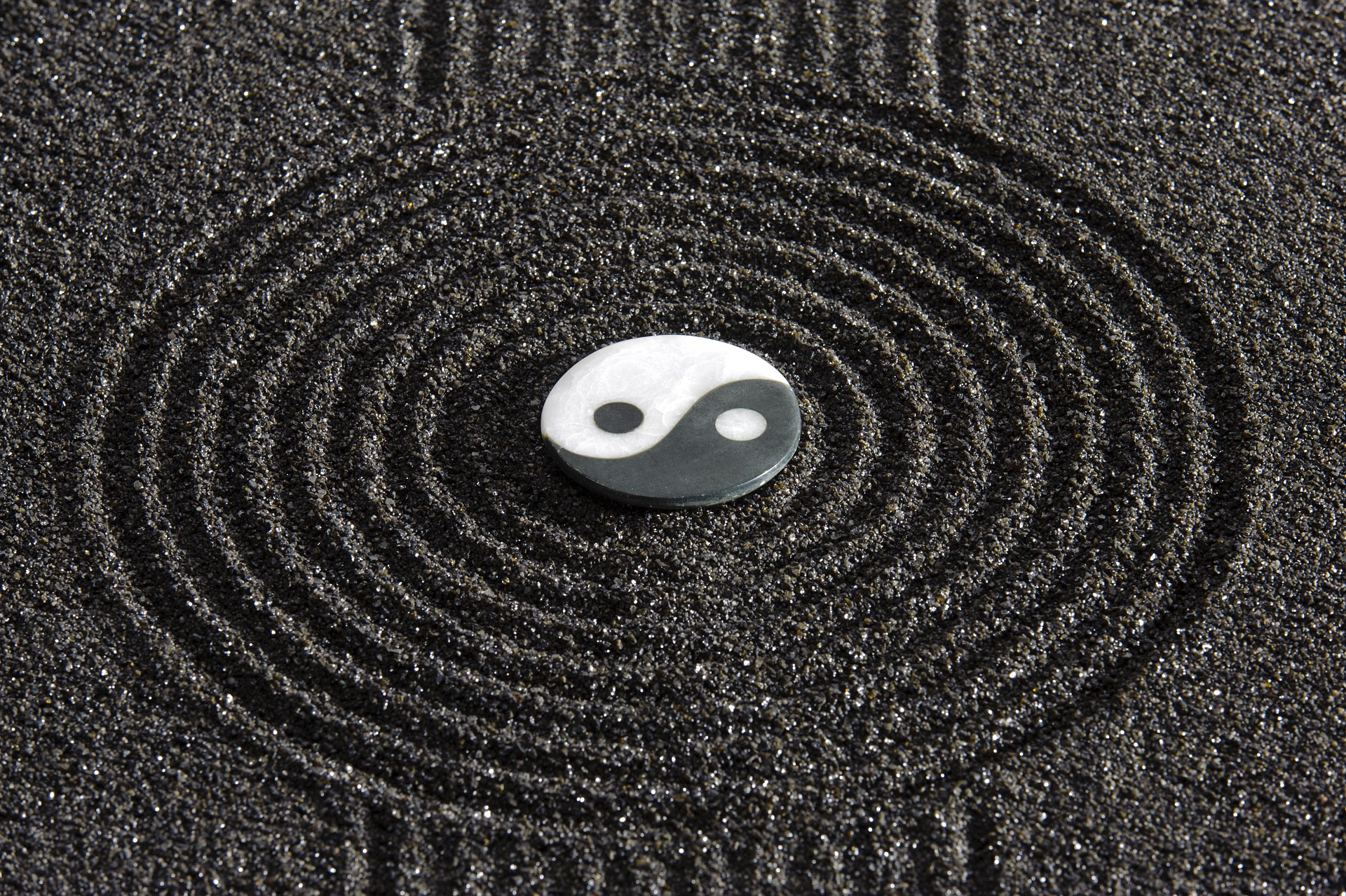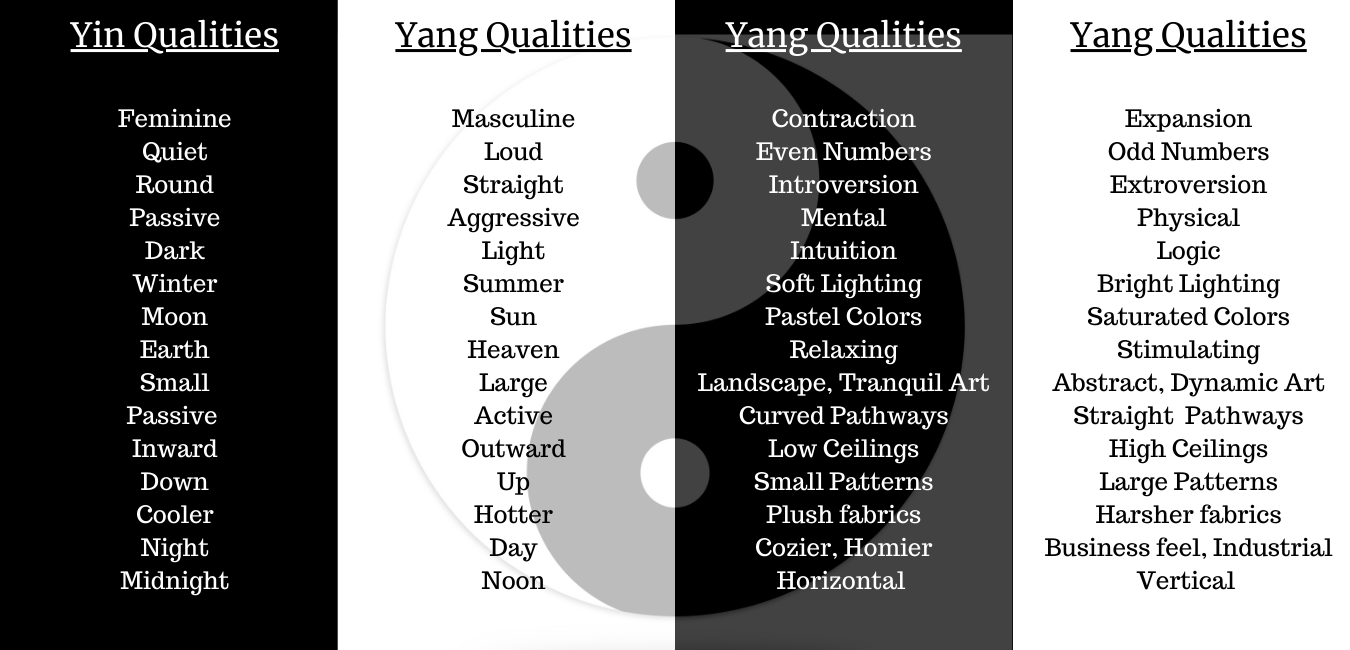Using Yin and Yang in Feng Shui for Balance and Harmony

Yin and Yang in Feng Shui
The theory of Yin and Yang is one of the foundational principles of Feng Shui. Originating in ancient Chinese philosophy and metaphysics, it describes two opposing, yet complementary forces found in all things in the universe. In Feng Shui, we use these terms to describe how something relates to something else; how something is more yin or more yang in comparison to the other. We also might say we need to add some yin or yang to a space. Nothing is only yin, and nothing is only yang. For good Feng Shui, we want these two energies to be in balance and harmony. By balance, it does not mean that they must be exactly equal. We always keep in mind how someone’s space is being used and what their needs are.
Yin attributes are considered the more “feminine” energies including darker, smaller, quieter, rounder, curvier, and softer, whereas yang attributes are considered the more “masculine” including lighter, larger, louder, angular, straight, harder, and more active.
Yin and yang are interdependent. One cannot exist without the other. The energies are in a continuous state of change, transforming one into the other. Without darkness, we wouldn’t know what light is and without light, we wouldn’t know what darkness is. Without cold, we do not know what hot is, and so on and so on.
Yin and yang can be applied to everything in our lives, including things such as our foods and activities. Fruits and salads would be more yin and cooked meat and processed foods would be more yang. Traditional Chinese medicine uses this theory in diagnosing ailments and prescribing recommended foods and activities to achieve balance. Rigorous exercise would be a yang activity whereas meditation would be a yin activity.
So much of Feng Shui is about achieving balance and harmony. Adding a bit of yin here and a bit of yang there helps us achieve this. It is one more Feng Shui tool we have to work with. Too much yang is exhausting, too much yin can be stagnant. If a room feels too still, we will want to add some yang energy. If it is too active, then we want to bring in some yin energy.
Life feels much better when it is balanced, but there are times when we want more of one or the other. If you were designing a spa, you would want a more yin environment. Maybe using soft green colors or a more muted or neutral palette. Soft music, dimmer lighting, calm pictures of nature. If you were designing a family pizza parlor, you would want a more yang environment. Perhaps a red color scheme, checkered tablecloths, move lively music.
As a rule of thumb, we want bedrooms to be very yin because it helps people relax and sleep better. Modern white bedrooms are very popular, but often people don’t sleep well in them. White is very yang. You might want to add some darker colors to slow the energy down. One of the reasons mirrors in bedrooms are not recommended is because they bring in a lot of yang energy. Mirrors double whatever they are reflecting, so now instead of a couple sleeping in a room, you now have the energy of four people in the room.
For kitchens and living rooms we generally want more yang. Or maybe you have a family room or den where higher energy feels better. Of course, again, everything depends on the needs of the people living there. A person might have a very busy action-filled (yang) job, then wants to create a more relaxing (yin) environment to come home to. Everyone’s home should be their sanctuary, and that will be different for each person or family.
Not only is this about how the space looks, but how the space feels and affects you. Too much yang can make people agitated, angry, and have anxiety and too much yin can make people lethargic, uninspired, and in the extreme, depressed.
There is even a yin side and a yang side to adding Feng Shui cures or remedies. The yin part would be the intention and visualization of why you are adding a certain remedy and what you are trying to change in your life. The yang part is the actual physical action of placing the cure.

If you like, try putting this into action. Take a look around your space, going room by room. Take your time and intuitively sense whether it feels in balance or not. And there is no right or wrong here. Reminder, the balance doesn’t have to mean equal yin and yang. Just adding some of one or the other can make a space feel more harmonious. We each have different lifestyles and needs. Do you need to bring more yin to your life? Or perhaps as we are coming out of the pandemic, you want to add some more yang.
Here are a few suggestions:
- Adding dimmer switches or changing out light bulbs can add more yin or yang depending. I used to never pay attention to light bulbs but now I have bright, crisp white light ones in certain areas and softer ones in the bedroom. Occasionally I’ll buy pink light bulbs which are really nice and soft for the bedroom.
- Adding a soft, plush throw blanket over a sofa or chair can make a whole room feel cozier if you want to add some yin.
- Add a colorful throw or pillows if you want to add some yang.
- Perhaps hardwood floors need a little softness, so you can add a rug.
- Or the opposite, perhaps marble flooring feels too cold, and you add a rug to add some warmth.
- What kind of art do you have on the walls and what are you trying to achieve? Large abstract art in bright colors would be very yang. Swapping out art pieces can calm down or energize a room. Smaller watercolor art would be more yin.
- Plants with softer, rounder leaves or fresh flowers can add some yin to a modern space, but if the space is very low energy, those same flowers can add a pop of yang.
- Perhaps a child is not sleeping well, and they have a bed in the shape of a car with red sheets on it. That would be a lot of yang energy. Try swapping the sheets out with more neutral, muted colors or earth tones.
- Loud rock music would be yang and classical, relaxing music would be yin.
- Generally, patterns are more yang than solid colors.
There are so many ways to change the yin or yang of a space and these are just a few ideas. As always, I hope they have given you some inspiration to look at your space through Feng Shui eyes. Feng Shui involves all of our surroundings and is a continuous process. It is not about being perfect, but about paying attention to our environments and making changes as we go along. And again, pay attention to how it makes you feel, not just how it looks.
Wishing everyone a beautifully balanced home and life!
